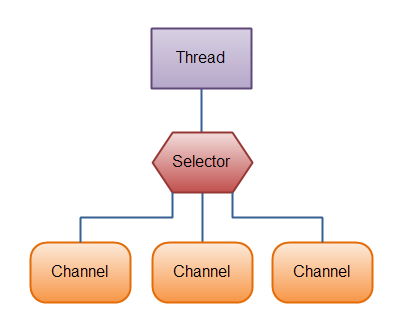Selector
转载自: http://ifeve.com/selectors/
为什么使用Selector?
仅用单个线程来处理多个Channels的好处是,只需要更少的线程来处理通道。事实上,可以只用一个线程处理所有的通道。对于操作系统来说,线程之间上下文切换的开销很大,而且每个线程都要占用系统的一些资源(如内存)。因此,使用的线程越少越好。
但是,需要记住,现代的操作系统和CPU在多任务方面表现的越来越好,所以多线程的开销随着时间的推移,变得越来越小了。实际上,如果一个CPU有多个内核,不使用多任务可能是在浪费CPU能力。在这里,只要知道使用Selector能够处理多个通道就足够了。
下面是单线程使用一个Selector处理3个channel的示例图:

Selector的创建
通过调用Selector.open()方法创建一个Selector,如下:
为了将Channel和Selector配合使用,必须将channel注册到selector上。通过SelectableChannel.register()方法来实现,如下:
注意register()方法的第二个参数。这是一个“interest集合”,意思是在通过Selector监听Channel时对什么事件感兴趣。可以监听四种不同类型的事件:
Connect
Accept
Read
Write
通道触发了一个事件意思是该事件已经就绪。所以,某个channel成功连接到另一个服务器称为“连接就绪”。一个server socket channel准备好接收新进入的连接称为“接收就绪”。一个有数据可读的通道可以说是“读就绪”。等待写数据的通道可以说是“写就绪”。
这四种事件用SelectionKey的四个常量来表示:
SelectionKey
当向Selector注册Channel时,register()方法会返回一个SelectionKey对象。这个对象包含了一些属性:
• interest集合
• ready集合
• Channel
• Selector
• 附加的对象(可选)
interest集合
就像向Selector注册通道中所描述的,interest集合是所选择的感兴趣的事件集合。可以通过SelectionKey读写interest集合,像这样:
ready 集合是通道已经准备就绪的操作的集合。在一次选择(Selection)之后,首先访问这个ready set。Selection将在下面进行解释。可以这样访问ready集合:
从SelectionKey访问Channel和Selector很简单。如下:
可以将一个对象或者更多信息附着到SelectionKey上,这样就能方便的识别某个给定的通道。例如,可以附加 与通道一起使用的Buffer,或是包含聚集数据的某个对象。使用方法如下:
通过Selector选择通道
一旦向Selector注册了一或多个通道,就可以调用几个重载的select()方法。这些方法返回所感兴趣的事件(如连接、接受、读或写)已经准备就绪的那些通道。换句话说,如果对“读就绪”的通道感兴趣,select()方法会返回读事件已经就绪的那些通道。
下面是select()方法:
• int select()
• int select(long timeout)
• int selectNow()
select()阻塞到至少有一个通道在你注册的事件上就绪了。
select(long timeout)和select()一样,除了最长会阻塞timeout毫秒(参数)。
selectNow()不会阻塞,不管什么通道就绪都立刻返回(此方法执行非阻塞的选择操作。如果自从前一次选择操作后,没有通道变成可选择的,则此方法直接返回零)。
一旦调用了select()方法,并且返回值表明有一个或更多个通道就绪了,然后可以通过调用selector的selectedKeys()方法,访问“已选择键集(selected key set)”中的就绪通道。如下所示:
可以遍历这个已选择的键集合来访问就绪的通道。如下:
注意每次迭代末尾的keyIterator.remove()调用。Selector不会自己从已选择键集中移除SelectionKey实例。必须在处理完通道时自己移除。下次该通道变成就绪时,Selector会再次将其放入已选择键集中。
某个线程调用select()方法后阻塞了,即使没有通道已经就绪,也有办法让其从select()方法返回。只要让其它线程在第一个线程调用 select()方法的那个对象上调用Selector.wakeup()方法即可。阻塞在select()方法上的线程会立马返回。
用完Selector后调用其close()方法会关闭该Selector,且使注册到该Selector上的所有SelectionKey实例无效。通道本身并不会关闭。
完整的示例
这里有一个完整的示例,打开一个Selector,注册一个通道注册到这个Selector上(通道的初始化过程略去),然后持续监控这个Selector的四种事件(接受,连接,读,写)是否就绪。
Selector(多路复用器)是Java NIO中能够检测一到多个NIO通道,并能够知晓通道是否为诸如读写事件做好准备的组件。这样,一个单独的线程可以管理多个channel,从而管理多个网络连接。
Java NIO的实现关键在于多路复用I/O技术,多路复用的核心就是通过Selected来轮询注册在其上的Channel,当发现某个或者多个Channel处于就绪状态后,从阻塞状态返回就绪的Channel的选择键集合,进行I/O操作。
为什么使用Selector?
仅用单个线程来处理多个Channels的好处是,只需要更少的线程来处理通道。事实上,可以只用一个线程处理所有的通道。对于操作系统来说,线程之间上下文切换的开销很大,而且每个线程都要占用系统的一些资源(如内存)。因此,使用的线程越少越好。
但是,需要记住,现代的操作系统和CPU在多任务方面表现的越来越好,所以多线程的开销随着时间的推移,变得越来越小了。实际上,如果一个CPU有多个内核,不使用多任务可能是在浪费CPU能力。在这里,只要知道使用Selector能够处理多个通道就足够了。
下面是单线程使用一个Selector处理3个channel的示例图:

Selector的创建
通过调用Selector.open()方法创建一个Selector,如下:
Selector selector = Selector.open();向Selector注册通道
为了将Channel和Selector配合使用,必须将channel注册到selector上。通过SelectableChannel.register()方法来实现,如下:
channel.configureBlocking(false); SelectionKey key = channel.register(selector, Selectionkey.OP_READ);与Selector一起使用时,Channel必须处于非阻塞模式下。这意味着不能将FileChannel与Selector一起使用,因为FileChannel不能切换到非阻塞模式。而套接字通道都可以。
注意register()方法的第二个参数。这是一个“interest集合”,意思是在通过Selector监听Channel时对什么事件感兴趣。可以监听四种不同类型的事件:
Connect
Accept
Read
Write
通道触发了一个事件意思是该事件已经就绪。所以,某个channel成功连接到另一个服务器称为“连接就绪”。一个server socket channel准备好接收新进入的连接称为“接收就绪”。一个有数据可读的通道可以说是“读就绪”。等待写数据的通道可以说是“写就绪”。
这四种事件用SelectionKey的四个常量来表示:
SelectionKey.OP_CONNECT SelectionKey.OP_ACCEPT SelectionKey.OP_READ SelectionKey.OP_WRITE如果对不止一种事件感兴趣,那么可以用“位或”操作符将常量连接起来,如下:
int interestSet = SelectionKey.OP_READ | SelectionKey.OP_WRITE;在下面还会继续提到interest集合。
SelectionKey
当向Selector注册Channel时,register()方法会返回一个SelectionKey对象。这个对象包含了一些属性:
• interest集合
• ready集合
• Channel
• Selector
• 附加的对象(可选)
interest集合
就像向Selector注册通道中所描述的,interest集合是所选择的感兴趣的事件集合。可以通过SelectionKey读写interest集合,像这样:
int interestSet = selectionKey.interestOps(); boolean isInterestedInAccept = (interestSet & SelectionKey.OP_ACCEPT) == SelectionKey.OP_ACCEPT; boolean isInterestedInConnect = interestSet & SelectionKey.OP_CONNECT; boolean isInterestedInRead = interestSet & SelectionKey.OP_READ; boolean isInterestedInWrite = interestSet & SelectionKey.OP_WRITE;
可以看到,用“位与”操作interest 集合和给定的SelectionKey常量,可以确定某个确定的事件是否在interest 集合中。
ready 集合是通道已经准备就绪的操作的集合。在一次选择(Selection)之后,首先访问这个ready set。Selection将在下面进行解释。可以这样访问ready集合:
int readySet = selectionKey.readyOps();可以用像检测interest集合那样的方法,来检测channel中什么事件或操作已经就绪。但是,也可以使用以下四个方法,它们都会返回一个布尔类型:
selectionKey.isAcceptable(); selectionKey.isConnectable(); selectionKey.isReadable(); selectionKey.isWritable();Channel + Selector
从SelectionKey访问Channel和Selector很简单。如下:
Channel channel = selectionKey.channel(); Selector selector = selectionKey.selector();附加的对象
可以将一个对象或者更多信息附着到SelectionKey上,这样就能方便的识别某个给定的通道。例如,可以附加 与通道一起使用的Buffer,或是包含聚集数据的某个对象。使用方法如下:
selectionKey.attach(theObject); Object attachedObj = selectionKey.attachment();还可以在用register()方法向Selector注册Channel的时候附加对象。如:
SelectionKey key = channel.register(selector, SelectionKey.OP_READ, theObject);
通过Selector选择通道
一旦向Selector注册了一或多个通道,就可以调用几个重载的select()方法。这些方法返回所感兴趣的事件(如连接、接受、读或写)已经准备就绪的那些通道。换句话说,如果对“读就绪”的通道感兴趣,select()方法会返回读事件已经就绪的那些通道。
下面是select()方法:
• int select()
• int select(long timeout)
• int selectNow()
select()阻塞到至少有一个通道在你注册的事件上就绪了。
select(long timeout)和select()一样,除了最长会阻塞timeout毫秒(参数)。
selectNow()不会阻塞,不管什么通道就绪都立刻返回(此方法执行非阻塞的选择操作。如果自从前一次选择操作后,没有通道变成可选择的,则此方法直接返回零)。
select()方法返回的int值表示有多少通道已经就绪。亦即,自上次调用select()方法后有多少通道变成就绪状态。如果调用 select()方法,因为有一个通道变成就绪状态,返回了1,若再次调用select()方法,如果另一个通道就绪了,它会再次返回1。如果对第一个就绪的channel没有做任何操作,现在就有两个就绪的通道,但在每次select()方法调用之间,只有一个通道就绪了。
一旦调用了select()方法,并且返回值表明有一个或更多个通道就绪了,然后可以通过调用selector的selectedKeys()方法,访问“已选择键集(selected key set)”中的就绪通道。如下所示:
Set selectedKeys = selector.selectedKeys();当像Selector注册Channel时,Channel.register()方法会返回一个SelectionKey 对象。这个对象代表了注册到该Selector的通道。可以通过SelectionKey的selectedKeySet()方法访问这些对象。
可以遍历这个已选择的键集合来访问就绪的通道。如下:
Set selectedKeys = selector.selectedKeys();
Iterator keyIterator = selectedKeys.iterator();
while(keyIterator.hasNext()) {
SelectionKey key = keyIterator.next();
if(key.isAcceptable()) {
// a connection was accepted by a ServerSocketChannel.
} else if (key.isConnectable()) {
// a connection was established with a remote server.
} else if (key.isReadable()) {
// a channel is ready for reading
} else if (key.isWritable()) {
// a channel is ready for writing
}
keyIterator.remove();
}这个循环遍历已选择键集中的每个键,并检测各个键所对应的通道的就绪事件。
注意每次迭代末尾的keyIterator.remove()调用。Selector不会自己从已选择键集中移除SelectionKey实例。必须在处理完通道时自己移除。下次该通道变成就绪时,Selector会再次将其放入已选择键集中。
SelectionKey.channel()方法返回的通道需要转型成你要处理的类型,如ServerSocketChannel或SocketChannel等。
某个线程调用select()方法后阻塞了,即使没有通道已经就绪,也有办法让其从select()方法返回。只要让其它线程在第一个线程调用 select()方法的那个对象上调用Selector.wakeup()方法即可。阻塞在select()方法上的线程会立马返回。
如果有其它线程调用了wakeup()方法,但当前没有线程阻塞在select()方法上,下个调用select()方法的线程会立即“醒来(wake up)”。
用完Selector后调用其close()方法会关闭该Selector,且使注册到该Selector上的所有SelectionKey实例无效。通道本身并不会关闭。
完整的示例
这里有一个完整的示例,打开一个Selector,注册一个通道注册到这个Selector上(通道的初始化过程略去),然后持续监控这个Selector的四种事件(接受,连接,读,写)是否就绪。
Selector selector = Selector.open();
channel.configureBlocking(false);
SelectionKey key = channel.register(selector, SelectionKey.OP_READ);
while(true) {
int readyChannels = selector.select();
if(readyChannels == 0) continue;
Set selectedKeys = selector.selectedKeys();
Iterator keyIterator = selectedKeys.iterator();
while(keyIterator.hasNext()) {
SelectionKey key = keyIterator.next();
if(key.isAcceptable()) {
// a connection was accepted by a ServerSocketChannel.
} else if (key.isConnectable()) {
// a connection was established with a remote server.
} else if (key.isReadable()) {
// a channel is ready for reading
} else if (key.isWritable()) {
// a channel is ready for writing
}
keyIterator.remove();
}
}